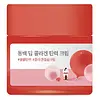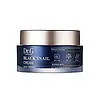What's inside
What's inside
 Key Ingredients
Key Ingredients

 Benefits
Benefits

 Concerns
Concerns

No concerns
 Ingredients Side-by-side
Ingredients Side-by-side

Water
Skin ConditioningGlycerin
HumectantPropanediol
SolventButylene Glycol
HumectantNiacinamide
SmoothingVinyldimethicone
Pentylene Glycol
Skin ConditioningDiphenylsiloxy Phenyl Trimethicone
Skin ConditioningCamellia Japonica Flower Extract
EmollientCaprylic/Capric Triglyceride
MaskingIsononyl Isononanoate
EmollientHydroxyethyl Acrylate/Sodium Acryloyldimethyl Taurate Copolymer
Emulsion StabilisingSodium Polyacrylate
AbsorbentAmmonium Acryloyldimethyltaurate/Vp Copolymer
Glycereth-25 PCA Isostearate
EmulsifyingCaprylyl Glycol
EmollientMethylpropanediol
SolventDimethiconol
EmollientCastor Oil/Ipdi Copolymer
Hydrolyzed Collagen
EmollientInositol
HumectantAllantoin
Skin ConditioningHydroxypinacolone Retinoate
Skin ConditioningLimnanthes Alba Seed Oil
Skin ConditioningCyanocobalamin
Skin ConditioningQuercetin
AntioxidantAdenosine
Skin ConditioningSorbitan Isostearate
EmulsifyingCitric Acid
BufferingDipotassium Glycyrrhizate
HumectantSoluble Collagen
HumectantSodium Phytate
Dimethyl Isosorbide
SolventArginine
MaskingCarbomer
Emulsion StabilisingSodium Citrate
BufferingEthylhexylglycerin
Skin ConditioningAmodimethicone
Xanthan Gum
EmulsifyingWater, Glycerin, Propanediol, Butylene Glycol, Niacinamide, Vinyldimethicone, Pentylene Glycol, Diphenylsiloxy Phenyl Trimethicone, Camellia Japonica Flower Extract, Caprylic/Capric Triglyceride, Isononyl Isononanoate, Hydroxyethyl Acrylate/Sodium Acryloyldimethyl Taurate Copolymer, Sodium Polyacrylate, Ammonium Acryloyldimethyltaurate/Vp Copolymer, Glycereth-25 PCA Isostearate, Caprylyl Glycol, Methylpropanediol, Dimethiconol, Castor Oil/Ipdi Copolymer, Hydrolyzed Collagen, Inositol, Allantoin, Hydroxypinacolone Retinoate, Limnanthes Alba Seed Oil, Cyanocobalamin, Quercetin, Adenosine, Sorbitan Isostearate, Citric Acid, Dipotassium Glycyrrhizate, Soluble Collagen, Sodium Phytate, Dimethyl Isosorbide, Arginine, Carbomer, Sodium Citrate, Ethylhexylglycerin, Amodimethicone, Xanthan Gum
Water
Skin ConditioningSnail Secretion Filtrate
Skin ConditioningDipropylene Glycol
HumectantGlycerin
HumectantCyclomethicone
EmollientCetearyl Alcohol
EmollientCaprylic/Capric Triglyceride
MaskingTriethylhexanoin
MaskingHydrogenated Polydecene
EmollientNiacinamide
SmoothingHydrogen
Antioxidant1,2-Hexanediol
Skin ConditioningOak Root Extract
Skin ConditioningCetearyl Glucoside
EmulsifyingGlyceryl Stearate Se
EmulsifyingMuscle Extract
Skin ProtectingButter Extract
EmollientPortulaca Pilosa Extract
Skin ConditioningCentella Asiatica Extract
CleansingFicus Indica Leaf Extract
Skin ConditioningRosa Indica Flower Extract
AntioxidantAverrhoa Bilimbi Leaf Extract
Skin ConditioningCitrus Iyo Fruit Extract
EmollientPlant Ash Extract
Aloe Vera Callus Extract
AntioxidantOcimum Basilicum Leaf Extract
Skin ConditioningTurtle Extract
EmollientCoral Extract
Skin ConditioningHydrogenated Lecithin
EmulsifyingArgania Spinosa Kernel Oil
EmollientSodium Hyaluronate
HumectantArachis Hypogaea Oil
Skin ConditioningCitrus Aurantium Bergamia Fruit Oil
MaskingCitrus Tangerina Peel Oil
MaskingGeranium Macrorrhizum Flower/Leaf/Stem Oil
MaskingCitrus Iyo Peel Oil
Rose Flower Oil
MaskingCitronellal
MaskingSantalum Album Oil
MaskingJasminum Officinale Oil
MaskingChamomilla Recutita Flower Oil
MaskingCitrus Limon Leaf Oil
MaskingFerula Galbaniflua Resin Oil
AntimicrobialRice Ferment Filtrate
Skin ConditioningDimethicone
EmollientSqualane
EmollientAlcohol
AntimicrobialGlyceryl Stearate
EmollientCetearyl Olivate
Sorbitan Oleate
EmulsifyingPEG-100 Stearate
2-Hydroxyethyl Acrylate
Cellulose
AbsorbentButylene Glycol
HumectantPalmitic Acid
EmollientHydrogenated Polyisobutene
EmollientBetaine
HumectantEthanolamine
BufferingPolysorbate 60
EmulsifyingPolyquaternium-51
Skin ConditioningGlycosyl Trehalose
Emulsion StabilisingIsononyl Isononanoate
EmollientPolyglyceryl-10 Stearate
Skin ConditioningCellulose Gum
Emulsion StabilisingTriticum Vulgare Starch
AbrasiveHydrogenated Starch Hydrolysate
HumectantRaffinose
Skin ConditioningBiosaccharide Gum-1
HumectantButyrospermum Parkii Butter
Skin ConditioningStearic Acid
CleansingAdenosine
Skin ConditioningPolyglyceryl-2 Dipolyhydroxystearate
Skin ConditioningBeta-Glucan
Skin ConditioningDisodium EDTA
Lecithin
EmollientSucrose
HumectantCaramel
Cosmetic ColorantPanthenol
Skin ConditioningInulin Lauryl Carbamate
Emulsion StabilisingLauryl Acrylate
Propylene Glycol
HumectantTitanium Dioxide
Cosmetic ColorantCoco-Caprylate/Caprate
EmollientTromethamine
BufferingFolic Acid
Skin ConditioningDisodium Stearoyl Glutamate
CleansingArabinose
HumectantPEG-30 Dipolyhydroxystearate
EmulsifyingCeramide NP
Skin ConditioningCholesterol
EmollientXanthan Gum
EmulsifyingTriethoxycaprylylsilane
Alumina
AbrasivePearl Powder
Palmitoyl Pentapeptide-4
Skin ConditioningParfum
MaskingEthylhexylglycerin
Skin ConditioningPhenoxyethanol
PreservativePentylene Glycol
Skin ConditioningCaprylyl Glycol
EmollientBenzyl Salicylate
PerfumingLimonene
PerfumingGeraniol
PerfumingHydroxycitronellal
PerfumingLinalool
PerfumingWater, Snail Secretion Filtrate, Dipropylene Glycol, Glycerin, Cyclomethicone, Cetearyl Alcohol, Caprylic/Capric Triglyceride, Triethylhexanoin, Hydrogenated Polydecene, Niacinamide, Hydrogen, 1,2-Hexanediol, Oak Root Extract, Cetearyl Glucoside, Glyceryl Stearate Se, Muscle Extract, Butter Extract, Portulaca Pilosa Extract, Centella Asiatica Extract, Ficus Indica Leaf Extract, Rosa Indica Flower Extract, Averrhoa Bilimbi Leaf Extract, Citrus Iyo Fruit Extract, Plant Ash Extract, Aloe Vera Callus Extract, Ocimum Basilicum Leaf Extract, Turtle Extract, Coral Extract, Hydrogenated Lecithin, Argania Spinosa Kernel Oil, Sodium Hyaluronate, Arachis Hypogaea Oil, Citrus Aurantium Bergamia Fruit Oil, Citrus Tangerina Peel Oil, Geranium Macrorrhizum Flower/Leaf/Stem Oil, Citrus Iyo Peel Oil, Rose Flower Oil, Citronellal, Santalum Album Oil, Jasminum Officinale Oil, Chamomilla Recutita Flower Oil, Citrus Limon Leaf Oil, Ferula Galbaniflua Resin Oil, Rice Ferment Filtrate, Dimethicone, Squalane, Alcohol, Glyceryl Stearate, Cetearyl Olivate, Sorbitan Oleate, PEG-100 Stearate, 2-Hydroxyethyl Acrylate, Cellulose, Butylene Glycol, Palmitic Acid, Hydrogenated Polyisobutene, Betaine, Ethanolamine, Polysorbate 60, Polyquaternium-51, Glycosyl Trehalose, Isononyl Isononanoate, Polyglyceryl-10 Stearate, Cellulose Gum, Triticum Vulgare Starch, Hydrogenated Starch Hydrolysate, Raffinose, Biosaccharide Gum-1, Butyrospermum Parkii Butter, Stearic Acid, Adenosine, Polyglyceryl-2 Dipolyhydroxystearate, Beta-Glucan, Disodium EDTA, Lecithin, Sucrose, Caramel, Panthenol, Inulin Lauryl Carbamate, Lauryl Acrylate, Propylene Glycol, Titanium Dioxide, Coco-Caprylate/Caprate, Tromethamine, Folic Acid, Disodium Stearoyl Glutamate, Arabinose, PEG-30 Dipolyhydroxystearate, Ceramide NP, Cholesterol, Xanthan Gum, Triethoxycaprylylsilane, Alumina, Pearl Powder, Palmitoyl Pentapeptide-4, Parfum, Ethylhexylglycerin, Phenoxyethanol, Pentylene Glycol, Caprylyl Glycol, Benzyl Salicylate, Limonene, Geraniol, Hydroxycitronellal, Linalool
 Reviews
Reviews

Ingredients Explained
These ingredients are found in both products.
Ingredients higher up in an ingredient list are typically present in a larger amount.
Adenosine is in every living organism. It is one of four components in nucleic acids that helps store our DNA.
Adenosine has many benefits when used. These benefits include hydrating the skin, smoothing skin, and reducing wrinkles. Once applied, adenosine increases collagen production. It also helps with improving firmness and tissue repair.
Studies have found adenosine may also help with wound healing.
In skincare products, Adenosine is usually derived from yeast.
Learn more about AdenosineButylene Glycol (or BG) is used within cosmetic products for a few different reasons:
Overall, Butylene Glycol is a safe and well-rounded ingredient that works well with other ingredients.
Though this ingredient works well with most skin types, some people with sensitive skin may experience a reaction such as allergic rashes, closed comedones, or itchiness.
Learn more about Butylene GlycolThis ingredient is an emollient, solvent, and texture enhancer. It is considered a skin-softener by helping the skin prevent moisture loss.
It helps thicken a product's formula and makes it easier to spread by dissolving clumping compounds.
Caprylic Triglyceride is made by combining glycerin with coconut oil, forming a clear liquid.
While there is an assumption Caprylic Triglyceride can clog pores due to it being derived from coconut oil, there is no research supporting this.
Learn more about Caprylic/Capric TriglycerideCaprylyl Glycol is a humectant and emollient, meaning it attracts and preserves moisture.
It is a common ingredient in many products, especially those designed to hydrate skin. The primary benefits are retaining moisture, skin softening, and promoting a healthy skin barrier.
Though Caprylyl Glycol is an alcohol derived from fatty acids, it is not the kind that can dry out skin.
This ingredient is also used as a preservative to extend the life of products. It has slight antimicrobial properties.
Learn more about Caprylyl GlycolEthylhexylglycerin (we can't pronounce this either) is commonly used as a preservative and skin softener. It is derived from glyceryl.
You might see Ethylhexylglycerin often paired with other preservatives such as phenoxyethanol. Ethylhexylglycerin has been found to increase the effectiveness of these other preservatives.
Glycerin is already naturally found in your skin. It helps moisturize and protect your skin.
A study from 2016 found glycerin to be more effective as a humectant than AHAs and hyaluronic acid.
As a humectant, it helps the skin stay hydrated by pulling moisture to your skin. The low molecular weight of glycerin allows it to pull moisture into the deeper layers of your skin.
Hydrated skin improves your skin barrier; Your skin barrier helps protect against irritants and bacteria.
Glycerin has also been found to have antimicrobial and antiviral properties. Due to these properties, glycerin is often used in wound and burn treatments.
In cosmetics, glycerin is usually derived from plants such as soybean or palm. However, it can also be sourced from animals, such as tallow or animal fat.
This ingredient is organic, colorless, odorless, and non-toxic.
Glycerin is the name for this ingredient in American English. British English uses Glycerol/Glycerine.
Learn more about GlycerinIsononyl Isononanoate is a synthetic skin-conditioner and texture enhancer. It is created from nonanoic acid, a fatty acid found in cocoa and lavender oil.
As an emollient, Isononyl Isononanoate helps keep your skin soft and smooth. This is because emollients create a barrier on the skin to trap moisture in.
Isononyl Isononanoate helps give products a velvet feel and improves spreadability.
Learn more about Isononyl IsononanoateNiacinamide is a multitasking form of vitamin B3 that strengthens the skin barrier, reduces pores and dark spots, regulates oil, and improves signs of aging.
And the best part? It's gentle and well-tolerated by most skin types, including sensitive and reactive skin.
You might have heard of "niacin flush", or the reddening of skin that causes itchiness. Niacinamide has not been found to cause this.
In very rare cases, some individuals may not be able to tolerate niacinamide at all or experience an allergic reaction to it.
If you are experiencing flaking, irritation, and dryness with this ingredient, be sure to double check all your products as this ingredient can be found in all categories of skincare.
When incorporating niacinamide into your routine, look out for concentration amounts. Typically, 5% niacinamide provides benefits such as fading dark spots. However, if you have sensitive skin, it is better to begin with a smaller concentration.
When you apply niacinamide to your skin, your body converts it into nicotinamide adenine dinucleotide (NAD). NAD is an essential coenzyme that is already found in your cells as "fuel" and powers countless biological processes.
In your skin, NAD helps repair cell damage, produce new healthy cells, support collagen production, strengthen the skin barrier, and fight environmental stressors (like UV and pollution).
Our natural NAD levels start to decline with age, leading to slower skin repair, visible aging, and a weaker skin barrier. By providing your skin niacinamide, you're recharging your skin's NAD levels. This leads to stronger, healthier, and younger looking skin.
Another name for vitamin B3 is nicotinamide. This vitamin is water-soluble and our bodies don't store it. We obtain Vitamin B3 from either food or skincare. Meat, fish, wheat, yeast, and leafy greens contain vitamin B3.
The type of niacinamide used in skincare is synthetically created.
Learn more about NiacinamidePentylene glycol is typically used within a product to thicken it. It also adds a smooth, soft, and moisturizing feel to the product. It is naturally found in plants such as sugar beets.
The hydrophilic trait of Pentylene Glycol makes it a humectant. As a humectant, Pentylene Glycol helps draw moisture from the air to your skin. This can help keep your skin hydrated.
This property also makes Pentylene Glycol a great texture enhancer. It can also help thicken or stabilize a product.
Pentylene Glycol also acts as a mild preservative and helps to keep a product microbe-free.
Some people may experience mild eye and skin irritation from Pentylene Glycol. We always recommend speaking with a professional about using this ingredient in your routine.
Pentylene Glycol has a low molecular weight and is part of the 1,2-glycol family.
Learn more about Pentylene GlycolWater. It's the most common cosmetic ingredient of all. You'll usually see it at the top of ingredient lists, meaning that it makes up the largest part of the product.
So why is it so popular? Water most often acts as a solvent - this means that it helps dissolve other ingredients into the formulation.
You'll also recognize water as that liquid we all need to stay alive. If you see this, drink a glass of water. Stay hydrated!
Learn more about WaterXanthan gum is used as a stabilizer and thickener within cosmetic products. It helps give products a sticky, thick feeling - preventing them from being too runny.
On the technical side of things, xanthan gum is a polysaccharide - a combination consisting of multiple sugar molecules bonded together.
Xanthan gum is a pretty common and great ingredient. It is a natural, non-toxic, non-irritating ingredient that is also commonly used in food products.
Learn more about Xanthan Gum